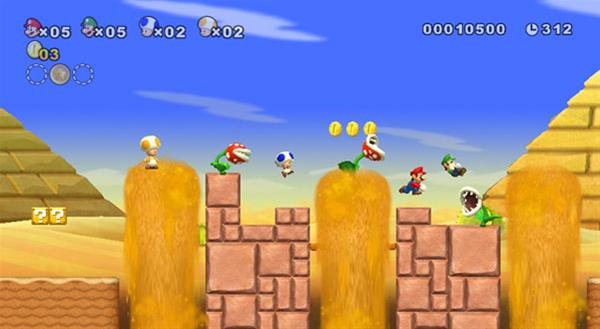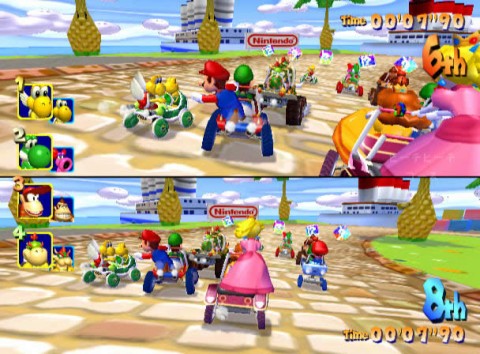Shared-Multi-Split Screen Design
 Wednesday, June 15, 2011 at 11:59AM
Wednesday, June 15, 2011 at 11:59AM In the early days, everyone received all of a video game's visual feedback from a single screen. Then came the Dreamcast VMU, multiple monitor displays for racing games and arcade cabinets, GBA to Gamecube connectivity, the Nintendo DS, iPhone to iPad connectivity, and now the Wii U. It's about time we take a look at video game screen design for real-time multiplayer experiences. First, we'll consider the design differences between split screen, shared screen, and multiple screen options.

4 players all fit on the screen.
Shared Screen
- Hardware Limitations: No other style of screen design can run with less hardware. One screen, one system, and sometimes one controller is all you need. Because all players share the same screen view, the system won't be over taxed having to render multiple views.
- Feedback: Some games successfully fit all players on the same screen without a problem. Others have to zoom out to keep everyone on screen. Depending on how much a game zooms out, the visual feedback fidelity may drop somewhat. However, the drop is generally negligible. Along the same lines, the audio feedback can be crowded depending on the the speaker setup of the system.
- Emergent Gameplay: When games allows players to exist and interact off the screen because of a lack of zoom or other accommodating features, new gameplay emerges. You may have to work to keep players on screen when you wouldn't have these considerations otherwise. Some games teleport lagging players forward (Donkey Kong Country Returns). Others kill the player if they're off the screen for too long (LittleBigPlanet). Some games prevent the characters from ever moving out of view with invisible walls (New Super Mario Bros Wii).
- With solo 2D games, cameras often follow the player. This feature helps players keep track of their avatars knowing that they'll always be in or near the center of the screen. With multiple players sharing the screen, it can become impossible to keep all players in the center of the screen. In these cases losing the ability to track your location via the camera position can be jarring. New Super Mario Bros Wii, Geometry Wars, and PixelJunk Shooter 2 have this problem as well as many others.
- Team Communication: Actions speak louder than words. A picture is worth a thousand words. Put these phrases together and it's obvious why watching other players via the shared screen is the most efficient, effective, and natural way to stay in sync. All of the actions both grand, subtle, and unconscious can be interpreted as a virtual body language. This puts less stress on making verbal callouts.

2 players. 1 split screen.
Split Screen
- Hardware Limitations: Many gamers detest split screen gaming because it generally forces a graphic drop in quality. Rendering additional camera views means the system must render up to twice as many textures, polygons, or sprites. It's also more difficult to lock in a consistent frame rate with split screen games.
- Feedback: Another reason why some gamers hate split screen gaming experiences is because of how splitting the screen reduces the visual feedback. For a single split, whether the split is vertical or horizontal through the middle of the screen, the resulting aspect ratios for both players will be different than for a solo player. So if gameplay is tuned so that a player gets all the necessary visual feedback when playing solo, chances are the feedback will suffer from a single split. Splitting the screen into 4 fixes the aspect ratio problem, but greatly shrinks the overall view. Only on the biggest screens or projectors does 4 player split screen not feel constricting. More splits also means more cluttered audio feedback. For example, if an enemy yells near one player in a 4 player split screen FPS, it can be impossible to tell which screen a sound originates from. All players may react to the threat.
- Emergent Gameplay: Along with camping, many FPS gamers can't stand screen-looking. Basically, instead of being blind to the other player's view, actions, and location when out of sight, you can simply look at their screen to spy on them. It's easy, effective, and difficult to avoid doing. And it doesn't just affect shooters. Pikmin 2 battle has the same issue. After screen-looking emerged, screen-blocking, playing in such a way to hide elements or obscure your view when playing a split screen multiplayer game, soon followed.
- Team Communication: Like shared screen gameplay with screen-looking you can observe the actions of teammates by looking at their screen. Using this more positive kind of screen-looking and verbal callouts is an effective combination.

The pros get a screen per person.
Multiple Screens
- Hardware Limitations: Currently to pull off multiple screen multiplayer between consoles, the units need to be networked. (Sony's Playstation TV is not out yet). Instead of processing additional camera views, most of the power can be devoted to running the game. Multiple screens also requires multiple CPU units, TV/monitors, and the networking equipment. It's the same for PCs. However, some PCs can connect to multiple monitors to run multiple screens.
- Feedback: When each player has their own audio/visual set up the feedback remain as clear as it does for solo play. Pro MLG Halo players play with individual TVs and special headsets.
- Emergent Gameplay: The more units are networked and the less reliable the connection and the more desynced the units can become potentially. Lag can make two players see two different realities depending on how the netcode is designed. Many gamers have gotten used to adjusting to actions that may or may not be real in the way that they appear.
- Team Communication: For 3D games with limited player perspectives like FPSs, callouts become very powerful tools. The more each player knows about what each player is doing and what they see, the stronger the team. Knowledge is power. And information is key. The more isolated each teammate is, the more powerful callouts become.
Now for interesting examples:
- GoldenEye/ Perfect Dark: Screen-looking perhaps started with these games. Interestingly, Perfect Dark has a feature to counter screen-looking. If you crouch and hold, your screen goes black. So if you have a good position, you can prevent your opponent from spying on your screen. It's not a perfect solution, but it works well enough.
- Pikmin 2 Battle: Like in Perfect Dark, you can obscure your opponent's screen. To prevent screen-looking, if you switch to the closest zoom view little can be seen on your screen. Combine this feature with the knapsack mechanic that commands your Pikmin to carry your sleeping body back to base and you can travel without revealing much to your opponent.
- Pac Man Vs: This game features multiple and split screen design. All the ghosts share the TV screen that's split into different views. The Pac Man player plays the game in the traditional way on the GBA screen (see image below). Because the ghost views are zoomed in, they have a harder time locating and trapping Pac Man. Working together ghost players need to take every advantage like screen-looking and callouts.

- Naruto Ultimate Ninja Storm: In this 1v1 fighter, both players share the same screen view. Sometimes the camera frames the players on the left and right side of the screen view like traditional 2D fighters. Other times the camera sits behind one player as he/she fights the opponent deep into the screen. The auto aim and tracking helps players land attacks regardless of the camera view. What's neat is that emergent moments of hide-&-seek are created. Kick up enough smoke and the player in the distance can launch a sneak attack, start a charge attack, or hide (see here).
- Puji: Because everyone shares a screen in this stealth assassin multiplayer game, everyone must hide out in the open. Because the NPCs look like the players, the gameplay is like a dynamic Where's Waldo. I'm amazed by how much strategy and depth there is in Puji mainly because of the incredibly simple shared screen design.
- Pokemon Stadium: A key part of competitive Pokemon battling is customising and concealing variable attributes like Pokemon moves, abilities, and held items. Like Poker, it's important to strike at the right moments and never reveal your hand unnecessarily. In this N64 battle simulator, both players share the screen. Cleverly, players can use the 4 C-buttons to select their attacks without ever revealing what they are on the TV screen. If need be, players can check which moves correspond to which C-button. Though doing so puts the Pokemon moves up on the screen, which one you select is still kept a secret.
- Bionic Commando Rearmed: This PSN retro remake has as dynamic splitscreen system. When players are close they share a screen. When players move beyond the limit that the camera can zoom out, the screen splits either vertically or horizontally (see here).
- Portal 2: Players have the option to play this co-op game splitscreen or multiscreen. Regardless of the mode, players have a special mechanics that aid in team communication (see here). These mechanics go a long way in helping players look in the same direction within complex 3D environments and coordinate timing. On a side note, for the purpose of a smooth co-op experience, I think splitscreen or is the better option. Simply looking at a partner's screen while they explain a plan can be far more effective than using the special communication mechanics. Furthermore, there are many moments when one player has little to do and little to look at while the other completes part of the puzzle. With split screen, you can enjoy what the game looks like from their point of view while you wait.

- The Legend of Zelda: Four Swords Adventures: In this Gamecube game, all players share the same TV screen view until they enter special building, caves, or areas where players are transferred to their private GBA screens. Since each player has their own GBA controller, the GBA gameplay uses multiple screen design. Between multiple GBAs or the GBA and the TV screen players, callouts become more important. This design also allows for sneak attacks and secret actions if players purposefully don't communicate. There are many puzzles in the game that stress multiple and shared screen design. In terms of audio feedback, on the GBAs each player has their own personal speaker making individual actions with unique sounds easy to identify. In other words, when you can't see what your friend is doing, that classic Zelda item acquisition theme coming from his/her GBA speaker can tip you off.
- The Legend of Zelda: Spirit Tracks battle mode: This game is very similar to Zelda: Four Swords. The top screen contains a map of the battle field so that all players can spot the position of force gems, enemies, other players, traps, etc. At the same time, each player has their own private view on their individual DS touch screen.
The list goes on. Once you understand the pros and cons of each type of screen design, you can begin innovating. Of course, it helps to have a system like the Wii U that offers a wide range of screen design flexibility espeically if you pair it with the DS/3DS. Even if you're not a game designer, it's fun to think of new ideas like in this NeoGAF thread.

